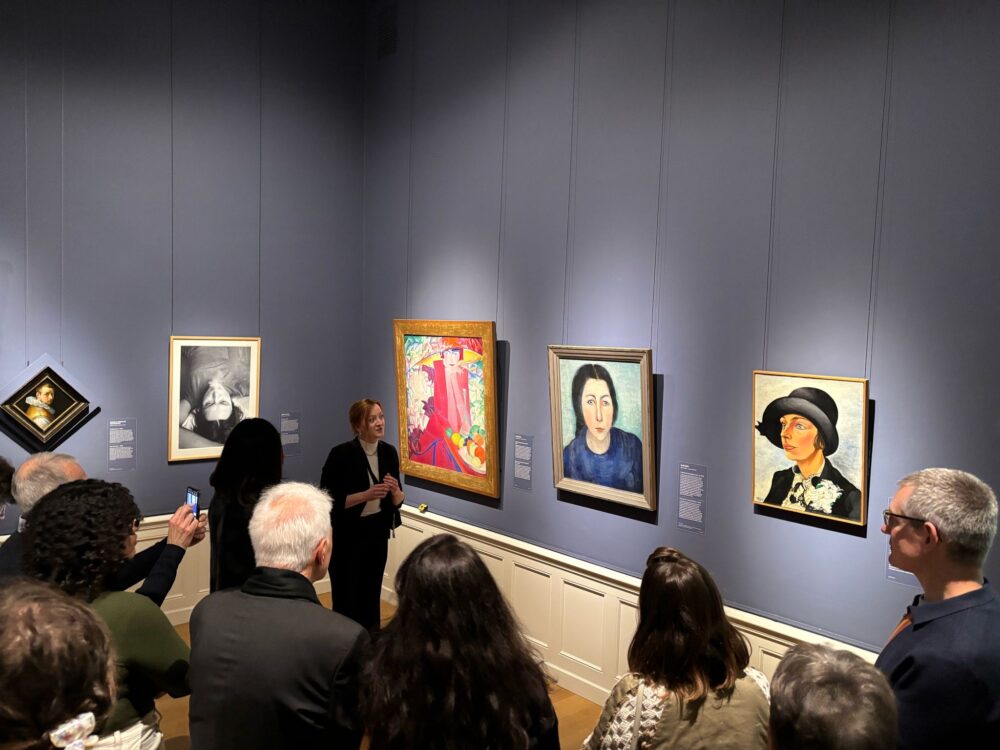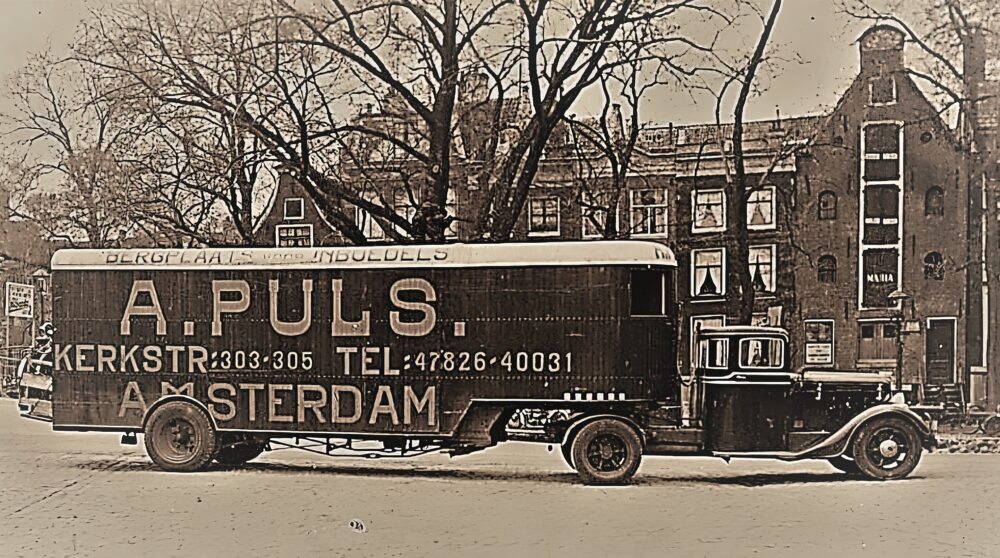Else Berg, who died in the Holocaust
Else Berg was a modernist Jewish artist who played a significant role in European avant-garde circles in the early 20th century.
Trained at the Royal Academy of Fine Arts in Antwerp, Belgium, and the Berlin University of the Arts in Germany, she focused on painting as her primary discipline.
Her work embraced the hallmarks of modernism — abstraction, innovation and self-expression — and her portraits share affinities with the stylistic sensibility of Amedeo Modigliani.
After extensive travels through Eastern Europe with her husband, the established painter Mommie Schwarz (1876–1942), Berg settled in Amsterdam.
When the Nazis came to power, many of their friends and family fled to England or the US. Berg and Schwarz initially felt safe in the Netherlands, but when the wearing of the yellow badge became compulsory, they refused and went into hiding in the village of Baambrugge.
After returning to their studio apartment in the Sarphatipark, Amsterdam, they were ultimately betrayed and arrested in November 1942. Both were deported to Auschwitz and murdered shortly after their arrival on 19 November.
Their possessions, including artworks, were probably looted in the same fashion as the homes of more than 140 000 Jews in the Netherlands — emptied by Abraham Puls & Sons, the notorious Amsterdam moving company that collaborated with Nazi-directed Dutch police.
 Frame of reference: The handing-over ceremony at the Frans Hals Museum in the Netherlands for a portrait (top centre, woman in blue) by Else Berg, who died in the Holocaust
Frame of reference: The handing-over ceremony at the Frans Hals Museum in the Netherlands for a portrait (top centre, woman in blue) by Else Berg, who died in the Holocaust
Following World War II, it was mistakenly assumed that Berg and Schwarz had no surviving family. It is now known that they did and these heirs are the rightful claimants to any of Berg’s looted possessions.
Professor Frederik P Scott (1915–1976), a medical student from the University of the Witwatersrand, travelled to the Netherlands in 1938 with a scholarship from the Dutch-South African Association for Medical Education to complete his studies at the Rijksuniversiteit of Groningen.
He lodged with the artist Sebastiaan Galis, whose mentorship extended far beyond the domestic. Galis introduced Scott to the De Ploeg artists’ collective and helped nurture his interest in visual art.
When World War II broke out, Scott remained in the Netherlands, graduating in 1942 and working at the Groninger Academisch Ziekenhuis — The University Medical Centre Groningen.
In Groningen, he met and married Dora Bossart. After the war, the Scott family — including their son Willem, born in 1944 — was evacuated to England and then repatriated to South Africa aboard a cargo vessel in December 1945.
In 1955, Scott returned to the Netherlands for a sabbatical year to specialise in dermatology at the former Klinisch Ziekenhuis Binnengasthuis hospital. Rekindling ties with Galis, he received as a gift Portret van Een Jonge Vrouw (circa 1913) by Else Berg — one of two Berg paintings Galis had acquired for a few gulden at the Waterlooplein flea market in Amsterdam after the war.
Thus began Scott’s lifelong engagement with art. In addition to his dermatological practice, he became a collector, connoisseur and author, assembling an extensive collection of South African and European works.
The Berg portrait always held an important place in his collection, though questions about its whereabouts between 1942 and 1945 lingered. How had the painting ended up at the Waterlooplein market? Could it have been part of a Puls & Sons clearance?
Art historian Linda Horn, author of Else Berg en Mommie Schwarz: Kunstenaarspaar in Amsterdam 1910–1942 (De Vrije Uitgevers, 2012), researched the provenance of Berg’s oeuvre and proposed various legal avenues for addressing the painting’s history. However, the possibility of wartime looting could not definitively be ruled out.
After the 1998 Washington Conference on Holocaust-Era Assets and the publication of the Washington Principles, a framework was established to enable the restitution of Nazi-confiscated artworks.
The Scott heirs chose to be guided by these principles and resolved to return the painting to its cultural roots by donating it to a museum in the Netherlands. Recognising that museums might hesitate to accept works with incomplete provenance records, it was essential to secure the full support of the rightful heirs.
With Horn’s help, contact was made with Else Berg’s heirs in the UK. The Winter and Berg families gave their approval, agreeing that donation to a Dutch museum would be a fitting and dignified resolution.
While the process was amicable, it was not without complications. Two prominent museums were honoured to be considered as custodians but ultimately declined. Either the painting did not align with their collecting strategy or they feared it might end up in storage and not be exhibited.
Debate emerged among Berg’s heirs regarding the ideal destination for the painting. One perspective advocated for its inclusion in a Jewish historical institution, such as the Yad Vashem Museum of Holocaust Art in Jerusalem, to honour Berg’s tragic fate. Another emphasised her rightful place in the modernist canon.

As Fred Scott (Junior) noted in his correspondence: “Else Berg’s art practice was primarily driven by a desire to engage with the formal challenges that defined early 20th-century modernism.
“Her distinctive style and refined aesthetic sensibility introduced a fresh and expressive visual language. Notably, her use of large planes — broad, flat areas of colour or tone — played a significant role in shaping modern artistic standards in Europe.
“In her portraiture, Berg often elongated and simplified facial features, using these planes to construct a sense of volume and structure. Through the reduction of forms to their essentials, and the bold application of colour and simplified shapes, she achieved portraits that were both striking and deeply expressive, capturing the essence of her sitters.
“Given the innovative qualities of her work and its relevance to the evolution of European modernism, we believe this painting merits renewed consideration within its original cultural and art historical context.”
After further discussion, consensus was reached that the painting should return to the Netherlands — to an institution more closely aligned with Berg’s artistic legacy than a Holocaust memorial institution.
The Frans Hals Museum in Haarlem graciously accepted the donation. In heartfelt correspondence, the museum’s curator of modern art, Maaike Rikhof, wrote: “We are utterly delighted and grateful that our museum collection will soon be complemented by the wonderful portrait by Else Berg!”
The painting, once acquired by Galis on the Waterlooplein, has now arrived safely in Haarlem.
“What an amazing experience to finally be able to admire it in person,” Rikhof wrote. “The vibrant colours and soft brushwork are striking, as is the melancholic gaze of the woman depicted.”
The museum has announced plans to include Portret van Een Jonge Vrouw in its new permanent collection presentation this year, alongside Berg’s Zelfportret met Penselen (circa 1929) and a portrait of her by Leo Gestel Dame met Grote Hoed in Prieel (1913).
“We thought it might be nice to celebrate the presence of Berg in this new presentation with those who helped make it possible,” Rikhof added.
This donation not only enhances the museum’s modern art collection but also helps restore and honour the legacy of Else Berg, a pioneering Jewish modernist who was silenced by the Holocaust.
On 27 February, the Frans Hals Museum held an event to mark the formal acceptance of the donation from the Scott family collection. The celebratory event included, alongside museum staff, members of the Scott family, the Berg and Winter heirs and Linda Horn.
The inclusion of Portret van Een Jonge Vrouw alongside Gestel’s early portrait of Berg carries special resonance for the Scott family. It closes the circle begun in the 1930s, when the young South African medical student, Professor Frederik P Scott first encountered Dutch modernist painting under the guidance of Sebastiaan Galis. More than 80 years later, that influence — anchored in friendship, historical circumstance and shared aesthetic passion — has found lasting form in the public reuniting of Berg’s image and legacy on Dutch soil.
The donation also gains deeper meaning in light of the reference to Else Berg in Steve McQueen’s 2023 film Occupied City, which movingly underlines the devastating impact of the Holocaust in the Netherlands and reaffirms the importance of preserving and remembering the lives and voices it sought to erase.